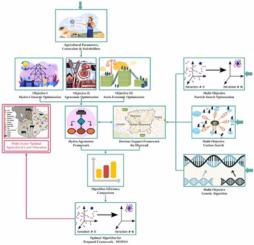Agricultural Water Management ( IF 5.9 ) Pub Date : 2022-04-13 , DOI: 10.1016/j.agwat.2022.107638 Gouri Sajith 1 , Rallapalli Srinivas 1, 2 , Alexander Golberg 3 , Joe Magner 2

|
Neoteric phenomena such as climate change, scarce water availability and excessive fertilizer usage necessitate an augmentation of resource utilisation efficiencies in the agricultural sector. There is a need to reorient the agroecosystems to curb stress on environmental resources while meeting rising socio-economic objectives under changing hydro-climatic conditions. Considering this, optimal land allocation for diversified agriculture is essential. We propose a combinatorial optimisation approach for land allocation considering agronomic, socio-economic, environmental and hydro-climatic objectives using bio-inspired optimization algorithms. The stochastic approach tackles the problem of optimal agricultural land allocation for crops in a multidimensional context by simultaneously addressing the conflicting goals of farm-level risk management as well as district-level contingency planning. The efficiencies and sensitivity of the proposed framework are assessed through a case study of the Dharwad district in Karnataka, India using the data (water and fertilizer consumption and cost, crop type, cultivable land, man and machine hours, etc.) from the year 2019–2020. Results indicate that Multi-objective Genetic Algorithm (MOGA) is more capable of optimising agricultural resources management by suggesting optimal land allocation for diversified crop planning. Although Cuckoo Search (CS) and Particle Search Optimisation (PSO) also produced productive Pareto fronts, they were observed to be less effective than MOGA. The annual increase in profits and crop yield obtained using MOGA are 103% and 97% respectively, while water usage is reduced by 5% compared to the conventional routines in Dharwad. The proposed hydro-agronomic decision support framework (DSF) can be utilised to assist the AI-enabled crop planning process for the sustainable management of agroecosystems.
中文翻译:

生物启发和人工智能为多样化农业管理提供水电经济模型
气候变化、水资源稀缺和过度使用化肥等新现象需要提高农业部门的资源利用效率。有必要重新调整农业生态系统的方向,以遏制对环境资源的压力,同时在不断变化的水文气候条件下满足不断提高的社会经济目标。考虑到这一点,多样化农业的最佳土地分配至关重要。我们使用仿生优化算法提出了一种考虑农艺、社会经济、环境和水文气候目标的土地分配组合优化方法。随机方法通过同时解决农场级风险管理和地区级应急计划的相互冲突的目标,解决了多维环境中作物的最佳农业用地分配问题。通过对印度卡纳塔克邦 Dharwad 地区的案例研究,使用当年的数据(水和肥料消耗量和成本、作物类型、可耕地、人和机器小时数等)评估了拟议框架的效率和敏感性2019-2020 年。结果表明,多目标遗传算法(MOGA)通过为多样化的作物规划提出最优土地分配,更有能力优化农业资源管理。尽管布谷鸟搜索(CS)和粒子搜索优化(PSO)也产生了富有成效的帕累托前沿,观察到它们不如 MOGA 有效。使用 MOGA 获得的利润和作物产量的年增长率分别为 103% 和 97%,而与 Dharwad 的传统程序相比,用水量减少了 5%。拟议的水利农艺决策支持框架 (DSF) 可用于协助支持人工智能的作物规划过程,以实现农业生态系统的可持续管理。










































 京公网安备 11010802027423号
京公网安备 11010802027423号